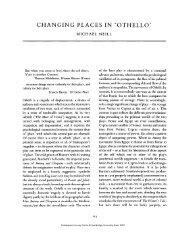the individualization of shakespeare's characters through imagery
the individualization of shakespeare's characters through imagery
the individualization of shakespeare's characters through imagery
You also want an ePaper? Increase the reach of your titles
YUMPU automatically turns print PDFs into web optimized ePapers that Google loves.
INDIVIDUALIZATION OF SHAKESPEARE'S CHARACTERS<br />
compost on <strong>the</strong> weeds to make <strong>the</strong>m ranker" (m, iv, 150). He compares Claudius to " a mildew'd<br />
ear" (m, iv, 64).<br />
Hamlet also makes use <strong>of</strong> images relating to food and <strong>the</strong> process <strong>of</strong> digestion. He says that his<br />
mo<strong>the</strong>r "would hang" on his fa<strong>the</strong>r "as if increase <strong>of</strong> appetite had grown by what it fed on"<br />
(1, ii, 144). Gertrude's marriage followed close upon <strong>the</strong> funeral <strong>of</strong> her first husband: "<strong>the</strong><br />
funeral baked tfieats did coldly furnish forth <strong>the</strong> marriage tables" (1, ii, 180). Hamlet avers that<br />
some people have <strong>the</strong> bad habit "that too much o'er-leavens <strong>the</strong> form <strong>of</strong> plausive manners"<br />
(1, iv, 29), i.e. that some people overdo <strong>the</strong>ir attempts to please. He calls a play that has not<br />
pleased <strong>the</strong> populace "caviare to <strong>the</strong> general" (11, ii, 425), i.e. too refined a delicacy. He speaks <strong>of</strong><br />
putting <strong>the</strong> king "to his purgation" (m, ii, 293). In ano<strong>the</strong>r passage he says that kings, like<br />
common people, are eaten in <strong>the</strong> grave by worms; <strong>the</strong> worm is eaten by a fish, <strong>the</strong> fish by a beggar,<br />
and thus, says Hamlet, a king "may go a progress <strong>through</strong> <strong>the</strong> guts <strong>of</strong> a beggar" (iv, iii, 34).<br />
Hamlet also uses images having to do with <strong>the</strong> human body. He likens a moral defect in a<br />
man to a mole (1, iv, 24). Self-deception is like a film forming over an ulcer "whilst rank corruption,<br />
mining all within, infects unseen" (m, iv, 147). Wars, he says, are caused by inner<br />
abscesses (iv, iv, 27).<br />
Most <strong>of</strong> Hamlet's comparisons and metaphors are simple, lucid, comprehensible and concretely<br />
substantial. He has no use for euphuism. No wonder he mocks Osric's flowery style<br />
(v, ii). He dislikes all showy externals, "<strong>the</strong> trappings and suits". "Seems, madam! nay, it is;<br />
I know not 'seems'", he tells Gertrude (1, ii, 76). He strives to understand life to <strong>the</strong> end, to<br />
approach it directly and face to face. All his thoughts are concentrated on man's earthly existence.<br />
It is <strong>the</strong>refore no wonder that his speeches abound, as we have seen, in <strong>the</strong> names <strong>of</strong> real objects<br />
and phenomena. Hamlet has a clear view <strong>of</strong> reality and things; <strong>the</strong>y wear no "romantic veil"<br />
for him.<br />
Hamlet is very observant. He sees right <strong>through</strong> people. He divined Claudius' criminal<br />
nature even before <strong>the</strong> apparition <strong>of</strong> <strong>the</strong> Ghost ("O my prophetic soul!" he exclaims upon<br />
learning from <strong>the</strong> Ghost who killed his fa<strong>the</strong>r—1, v, 40). He immediately realized that Rosencrantz<br />
and Guildenstern were concealing something from him. Ophelia's embarrassment when<br />
Claudius and Polonius are listening behind <strong>the</strong> arras does not escape his keen eyes. He recognizes<br />
Horatio's disinterested honesty. Hamlet is an observant man, a man <strong>of</strong> realistic mentality. At <strong>the</strong><br />
same time, however, Hamlet is a dreamer. Comparison <strong>of</strong> Hamlet with <strong>the</strong> author <strong>of</strong> Utopia<br />
naturally suggests itself. We may note here that Thomas More was also a realist. One had to see<br />
all <strong>the</strong> ugliness and imperfection <strong>of</strong> real life to hate injustice as Thomas More and Hamlet hated<br />
it, to refuse to accept this injustice and create a dream. Hamlet dreamt <strong>of</strong> <strong>the</strong> perfect man<br />
as passionately as did <strong>the</strong> author <strong>of</strong> Utopia <strong>of</strong> <strong>the</strong> perfect human society. The gulf between dream<br />
and reality, <strong>the</strong> impossibility, at that time, <strong>of</strong> bridging this gulf plunged both <strong>of</strong> <strong>the</strong>m into<br />
deep sorrow. Hamlet admired man, <strong>the</strong> nobility <strong>of</strong> his reason, his infinite faculty, but in<br />
<strong>the</strong> same breath he said that "man delights me not" (n, ii, 309). He called death felicity and<br />
said it was hard to brea<strong>the</strong> "in this harsh world" (v, ii, 361-2).<br />
Hamlet's images are <strong>of</strong>ten ra<strong>the</strong>r coarse. He compares Claudius to a toad, bat, and gib<br />
(in, iv, 190). He says that he should long since "have fatted all <strong>the</strong> region kites with this slave's<br />
<strong>of</strong>fal" (n, ii, 614). His ironic question "How now! a rat?" (ni, iv, 23) suggests a comparison <strong>of</strong><br />
Claudius to a rat (he had thought that it was Claudius behind <strong>the</strong> arras, and not Polonius). The<br />
95<br />
Shakespeare Survey Online © Cambridge University Press, 2007



